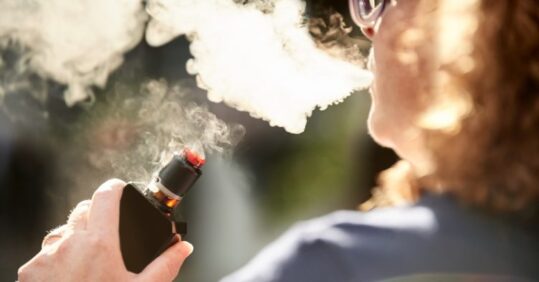Second-hand e-cigarette vapour increases risk of poor respiratory health, study finds

Young adults who are exposed to second-hand e-cigarette vapour at home have an increased risk of bronchitic symptoms and shortness of breath, an observational study has suggested.
Primary and second-hand exposure to vaping was highly prevalent among adolescents and young adults but there had been little research investigating the effects of second-hand vape exposure on respiratory health, researchers wrote in Thorax.
Using the prospective Southern California Children Health Study cohort, they analysed data from 2,097 participants who took part in at least one of four waves of health questionnaires starting in 2014 and followed up in 2015, 2017 and 2018.
Related Article: Prescribing in England to be led by a single national formulary
Second-hand nicotine vape exposure prevalence increased from 11.7% to 15.6% during the study period, the analysis found.
Prevalence of wheeze and bronchitic symptoms rose from 12.3% to 14.9%, and 19.4% to 26% during the study period, while breathlessness did not show a clear trend over time, ranging from 16.5% to 18.1%.
Bronchitic symptoms included any one of four criteria: bronchitis in the previous 12 months, daily cough in the morning for three consecutive months, daily cough at other times of the day for three months in a row, and/or congestion or phlegm that weren’t cold symptoms.
Wheeze was based on self-reported wheezing or whistling in the chest during the previous 12 months. Shortness of breath was based on reporting this symptom when hurrying on level ground or walking up a slight hill.
On analysing the data, researchers found second-hand nicotine vape exposure was associated with a 40% increased risk of bronchitic symptoms and a 53% increased risk of shortness of breath after controlling for vaping, active and passive exposure to tobacco and cannabis as well as demographic characteristics such as race, age, and gender.
‘Stronger associations were observed when the analysis was restricted to participants who were neither smokers nor vapers,’ the researchers noted.
Related Article: Advice on Guillain-Barré risk for adult RSV vaccine updated by MHRA
There were no associations with wheezing after adjusting for confounders, they added.
If the observed associations were found to be causal it would be warranted to prohibit e-cigarette smoke in public places.
’If causal, reduction of second-hand e-cigarette exposure in the home would reduce the burden of respiratory symptoms and would provide a compelling rationale for the regulation of e-cigarette use in public places,’ they concluded.
An accompanying editorial noted that vaping devices were originally marketed as a lower health risk nicotine replacement, but increasing evidence pointed to the contrary.
Related Article: Quick quiz: Management of COPD
‘More work needs to be done to prove that this exposure directly causes harm. Ultimately, this is a public health concern that – if not addressed – has the potential to negatively affect our population, including those who are most vulnerable,’ the editorial concluded.
It comes after a study found that pregnant women were more likely to quit smoking if they are given financial incentives to do so.

See how our symptom tool can help you make better sense of patient presentations
Click here to search a symptom




